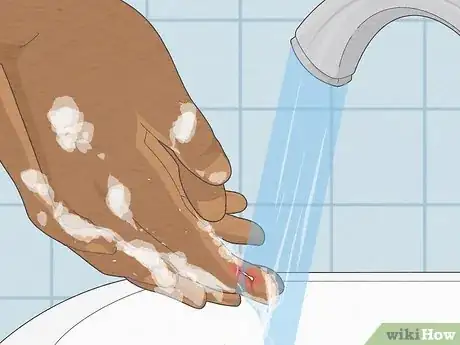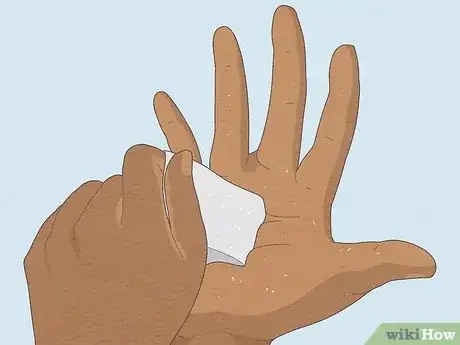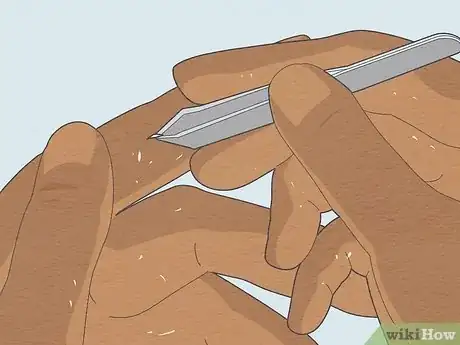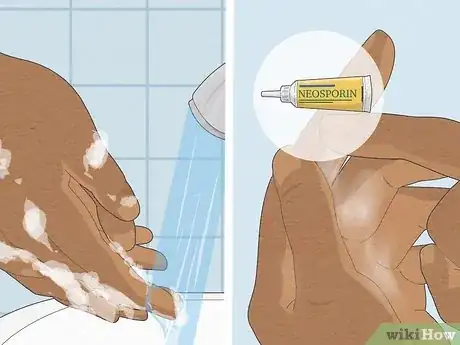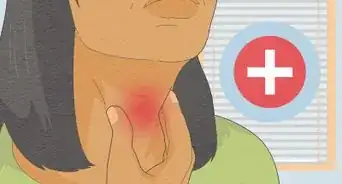This article was co-authored by Laura Marusinec, MD and by wikiHow staff writer, Glenn Carreau. Dr. Marusinec is a board certified Pediatrician at the Children's Hospital of Wisconsin, where she is on the Clinical Practice Council. She received her M.D. from the Medical College of Wisconsin School of Medicine in 1995 and completed her residency at the Medical College of Wisconsin in Pediatrics in 1998. She is a member of the American Medical Writers Association and the Society for Pediatric Urgent Care.
wikiHow marks an article as reader-approved once it receives enough positive feedback. This article received 13 testimonials and 100% of readers who voted found it helpful, earning it our reader-approved status.
This article has been viewed 989,810 times.
Have you been exposed to fiberglass while working on a renovation or construction project? Fiberglass is a common material found in many household products. However, it contains tiny glass fibers that can be a health hazard and irritate your skin, eyes, and throat. Read on for a comprehensive guide to removing fiberglass slivers from your skin and preventing incidents in the future with protective tips!
Things You Should Know
- Wash the exposed area with soap and water first. If you don’t see any visible splinters, wipe your skin with a washcloth to clear away the fiberglass.
- Remove a visible splinter by laying a piece of duct tape across it and pulling it up gently. Alternatively, use tweezers to pull the sliver out of your skin.
- Protect yourself in the future by covering your skin before you work. Wash your clothes and take a shower immediately after working with fiberglass.
Steps
Getting Fiberglass Out of Your Skin
-
1Wash the exposed area with mild soap and warm water. It’s common to have bacteria and germs on your skin, but those germs can cause an infection if they get under your skin through the nicks created by fiberglass splinters. Plus, water can wash away some of the fibers on your skin—although you’ll still have to remove embedded slivers later.[1]
- If you can clearly see a fiberglass splinter in your skin, gently pat the area dry with a towel before you move to the next steps and remove it.
- Fiberglass can be painful and harder to remove if left in your skin for long periods. If your bare skin is exposed to fiberglass, stop whatever you’re doing, if possible, and wash the exposed area as soon as you can.
-
2Wipe your skin with a wet washcloth to remove microscopic fibers. If your skin is itchy (or has simply touched fiberglass) but there aren’t any visible splinters, the easiest way to get rid of the fiberglass is to wipe the exposed area with a washcloth right after washing it with soap and water. Washing the area loosens the fiberglass so the washcloth can easily sweep it away.[2]
- Instead of a washcloth, you could also wipe your skin with a pair of pantyhose. The fabric will catch the fiberglass and pull it off your skin. Just be sure to throw out the pantyhose after using them like this!
- Don’t scratch or rub your skin, even if it’s itchy. That’ll just force break the fibers into smaller pieces and force deeper into your skin, making them harder to wipe away.
- Try applying some petroleum jelly after you wipe the exposed area instead of scratching it. Petroleum jelly soothes irritated skin.
Advertisement -
3Lift visible slivers out of your skin with adhesive tape. If you spot a fiberglass splinter, tear off a small strip of duct tape and carefully place it over each area with a fiberglass splinter. Ensure the tape makes firm contact with your skin and the sliver, then gently pull it off in a single smooth motion.[3]
- The fibers will stick to the duct tape and slide out of your skin when the tape is pulled away.
- Don’t rub the tape across your skin or push it on too forcefully. Lightly pat it, so you don’t push the sliver deeper into your skin.
- Duct tape is ideal because it’s sturdy and very sticky (with a lot of glue in the tape), so it can catch all the fiberglass without ripping as you remove it. You can also use electrical tape if it’s available.
-
4Use tweezers to remove a visible splinter, alternatively. Clean a pair of fine-tipped tweezers with rubbing alcohol and go to a well-lit area to extract the fiberglass sliver. Then, grasp the tip of the fibers with the tweezers and slowly pull them out of your skin. Just be gentle if you use a pair of tweezers since fiberglass splinters break more easily than other materials.[4]
- Thin fiberglass fibers are a white or light yellow color. They can be hard to spot, so good lighting is essential. Use a magnifying glass to find them, too, if necessary.
- If the fiber is under the surface of your skin, use a sterilized needle (cleaned with rubbing alcohol) to gently break the skin over the tip of the sliver and pull it up. Then you can quickly grab it with your tweezers.
-
5Rewash the area and apply an antibiotic ointment. After removing the fiberglass, give the area another gentle wash with warm water and soap. Then, pat the area dry and spread an antibiotic ointment over the area where you removed the sliver to prevent any germs from getting into the nick and causing an infection before it can heal.[5]
- Although protective ointments are a good safety measure, you don’t have to cover the site of the splinter with a band-aid since it shouldn’t be bleeding enough to need one.
- It’s also a good idea to take a shower as soon as you can after being exposed to fiberglass. A warm shower can wash away any other traces of fiberglass lingering on your skin.
-
6Monitor your skin for further irritation and consult a doctor if necessary. When fiberglass gets embedded and lingers in your outer layer of skin, common symptoms include a red rash and itchiness in the exposed area. Contact your healthcare provider if you develop a rash that doesn’t go away after any of the above removal methods. There may still be fiberglass slivers in your skin, which they can remove.[6]
- If your skin becomes red while also getting warmer or developing pus, you might have a skin infection. See your doctor right away to get antibiotics.
- Breathing in fiberglass can lead to respiratory symptoms, including coughing, sneezing, and itching. This happens because the glass fibers get trapped in your airways, and smaller ones can settle in your lungs.
- If any fibers are swallowed accidentally, you might also develop temporary stomach discomfort—though your body will naturally process and eject the fibers in time.
Protecting Yourself From Fiberglass Slivers
-
1Cover your skin as much as possible while working with fiberglass. Put on long sleeves and pants, thick work gloves, close-toed shoes, safety goggles, and a mask before you start working. The clothing should be loose-fitting and cover your arms and legs fully. The more coverage you have, the fewer chances you have of accidentally exposing bare skin to the fiberglass.[7]
- If your work involves cutting fiberglass, a standard face mask may not be enough protection; use a respirator instead.
- Consider wearing disposable coveralls over your base clothing to keep fiberglass filaments off of them as much as you can.
-
2Keep windows and doors open to increase airflow while you work. Opening windows and doors will reduce the dust levels in the room, which means you’re less likely to breathe in fiberglass dust as you work. It’ll also prevent so much fiberglass dust from settling on your clothing.[8]
- After working with fiberglass, wet the floor in that room and use a vacuum with a HEPA filter to collect and dispose of any remaining fiberglass dust. While open windows help, there will likely be some lingering fibers.
- Don’t dry sweep a floor with fiberglass dust on it; that’ll spread the dust around since many particles are too small to sweep up.
-
3Clean your hands before eating, drinking, or smoking. It’s always possible that a little fiberglass dust could get onto your hands while you work, so be sure to wash them with soap and water before handling anything near your mouth—like food, tissues, glasses, or cigarettes. If the fibers get into your mouth, they might irritate your throat or airways.[9]
- Don’t leave any food or drinks in the same room as the fiberglass. Store it outside your workspace and clean up before you leave for a snack break.
-
4Wash your clothing after exposure to fiberglass. Once you leave the work site, immediately get somewhere where you can remove your exposed clothing and wash it. Don’t wash the clothing with other garments; the fiberglass on your work clothes might transfer over to everything else. Machine wash your clothing as usual, then clean out your washing machine afterward.[10]
Warnings
- Fiberglass is often found in electrical insulation, anti-slip pads and grating, vehicle parts (like bumpers and doors), and various pool components. If you work with any of those materials, be cautious and wear protective gear.[13]⧼thumbs_response⧽
References
- ↑ https://bestdoctornearme.com/how-to-get-fiberglass-out-of-the-skin/
- ↑ https://bestdoctornearme.com/how-to-get-fiberglass-out-of-the-skin/
- ↑ https://www.contractorhq.org/removing-fiberglass-from-skin
- ↑ https://www.mayoclinic.org/first-aid/first-aid/basics/art-20056604
- ↑ https://www.mayoclinic.org/first-aid/first-aid/basics/art-20056604
- ↑ https://www.seattlechildrens.org/conditions/a-z/sliver-or-splinter/
- ↑ https://www1.nyc.gov/site/doh/health/health-topics/fiberglass.page
- ↑ http://www.idph.state.il.us/envhealth/factsheets/fiberglass.htm
- ↑ http://www.idph.state.il.us/envhealth/factsheets/fiberglass.htm
About This Article
To remove fiberglass slivers from your skin, press duct tape firmly onto the affected areas, hold it in place for several minutes, then pull it off in a smooth motion. Alternatively, sterilize tweezers with rubbing alcohol, and pull the tips of the fibers slowly away from your skin. If the splinters are embedded in the skin, use a sterilized needle to gently lift them up from the skin so you can grab them with the tweezers. To learn how to tell if you have an infection from fiberglass slivers, keep reading!
